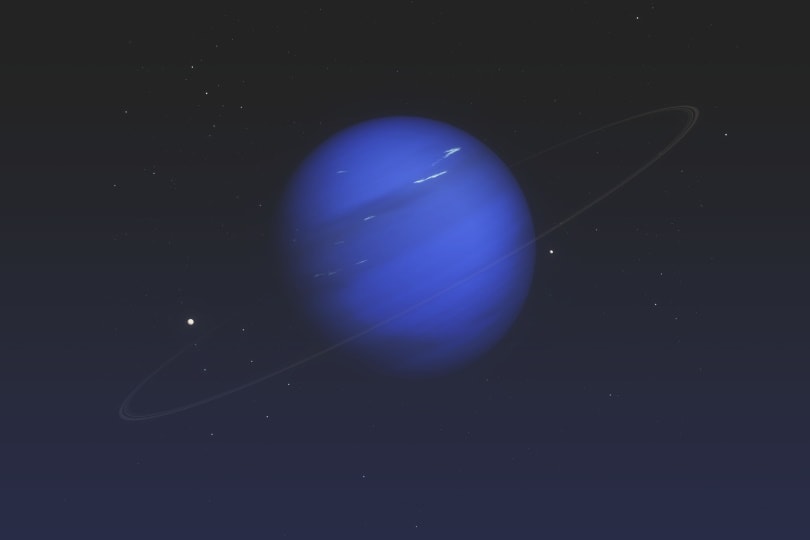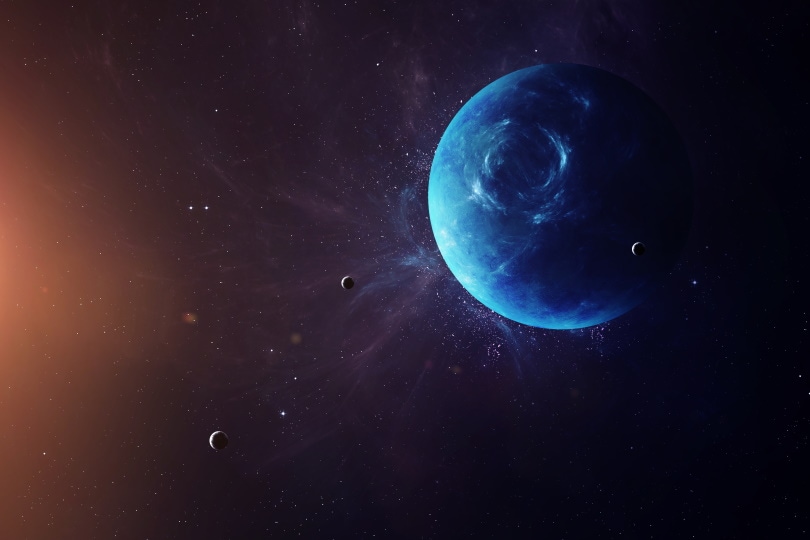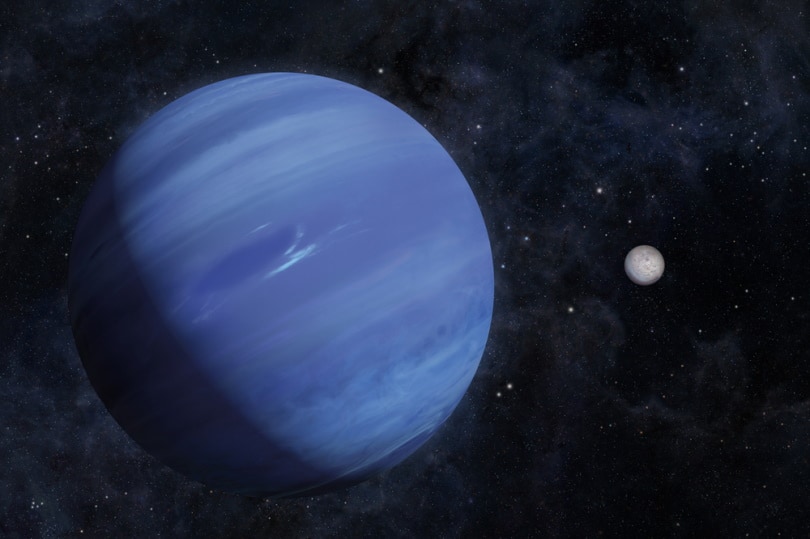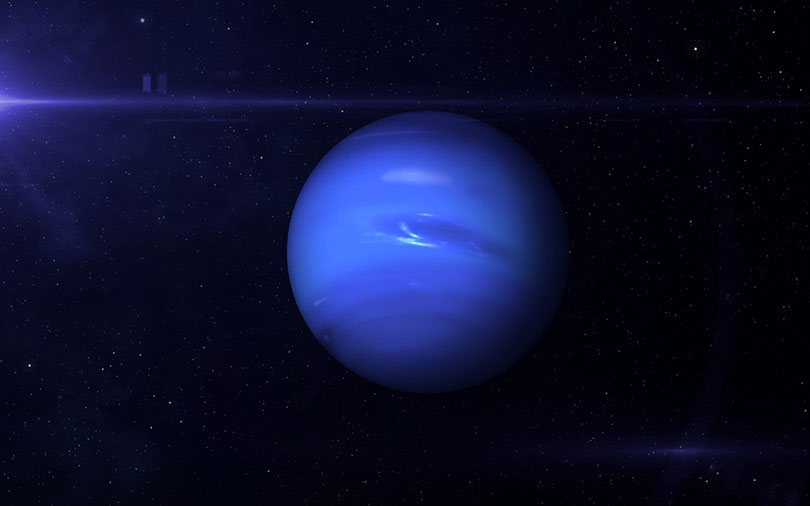How Big Is Neptune? What Is Its Composition?
Last Updated on

As the eighth planet from the Sun, Neptune is the most distant planet and the smallest gas giant in our solar system. Because Neptune is so far away from us, scientists don’t know much about it. This otherworldly realm is characterized by a brilliant azure blue color, ferocious winds, frigid temperatures, a plethora of moons, and its own planetary ring system.
Since the planet of extremes is perched on the outer edges of the solar system, only one spacecraft, Voyager 2, has been able to study Neptune up close. Most of what we know about Neptune comes from Voyager 2’s observations, including the discovery of five moons, four planetary rings, and a giant storm known as the “Great Dark Spot.” Let’s take a closer look at this fascinating and enthralling world to learn more about its size and physical characteristics.

Neptune’s Physical Size
In terms of radius, Neptune is the fourth-largest planet in the solar system, clocking in at an average radius of 15,299 miles. However, because of Neptune’s rotation, it has a slight bulge along its equator, which classifies the planet as an oblate spheroid. When measured at the poles, the average radius of Neptune is 15,125 miles, but at the equator, it is about 15,388 miles. Its average diameter is about 30,590 miles, nearly four times the size of Earth.

Neptune’s Mass & Volume
Neptune is more than 17 times as massive as Earth, despite being only four times larger. This icy planet weighs about 102 trillion trillion kilograms, which accounts for the rocks, ices, and gases that make up Neptune’s mass, at a density of approximately1.638 grams per cubic centimeter. This material fills up a volume of roughly 15 trillion cubic miles!
Neptune’s Composition
Neptune is characterized by a raging hot core about the size of Earth. It is likely composed of silicates and heavy metals such as iron and nickel, with pressures more than one million times stronger than on the surface of Earth. Surrounding the core is a thick soup of hot, dense fluid made up of water, ammonia, and methane. Above this layer is Neptune’s atmosphere, which is made of icy-cold fluid gases such as hydrogen, helium, and methane. Although methane makes up a tiny fraction of Neptune’s atmosphere, it is the reason for the planet’s brilliant azure color.

Weather on Neptune
Neptune is home to a plethora of fascinating weather phenomena that make it a planet of extreme scientific significance. As one of the coldest and windiest places in the solar system, the weather forecast on Neptune is genuinely astonishing. Neptune is so cold that anything would flash freeze instantly if exposed to its wrath.
At Neptune’s cloud tops, the temperatures were almost three times colder than anything ever measured on Earth, with measurements coming in around -366.6 °F. However, as we venture further into Neptune and the pressure starts to rise, so does the temperature.
Near Neptune’s core, temperatures are expected to exceed 12,632 °F, similar to those found on the Sun’s surface. This makes for some of our solar system’s most extreme temperature variations.
Neptune is also home to violent and ferocious winds, with wind speeds easily exceeding 1,500 mph. It is thought that Neptune’s atmospheric makeup and extremely cold temperatures reduce friction enough to generate winds that would easily put even the strongest Earthly hurricanes to shame. If that isn’t enough, astronomers and physicists also hypothesize that it rains diamonds on Neptune.
At the high-pressure zones deep in Neptune’s atmosphere, hydrocarbons like methane become chemically reactive and start to separate. The immense pressure and extreme heat are thought to crush the freed carbon molecules into their most stable form, which is diamond.
Because diamond is extremely dense, it is theorized that the resulting precious gems rain down and form a thick layer of diamond around Neptune’s core. Although this idea seems super far-fetched, in 2017, scientists were able to recreate the conditions deep within Neptune in a lab. The results were astonishing, with the expected formation of diamonds supporting the original hypothesis.


Summary
Neptune is a fascinating planet that is the subject of many cosmological mysteries. It is the farthest planet from the Sun and the smallest of the gas giants, although it is the fourth-largest planet in the solar system.
Neptune sports some of the most interesting weather phenomena among the planets and is an otherworldly realm that not much is known about, mainly since it is so far. This cold and distant world is characterized by its deep, vibrant blue color, which is enthralling. Although it’s been a long time since we’ve visited this fascinating planet, it’s definitely due for a visit soon.
Featured Image Credit: 95C, Pixabay
About the Author Robert Sparks
Robert’s obsession with all things optical started early in life, when his optician father would bring home prototypes for Robert to play with. Nowadays, Robert is dedicated to helping others find the right optics for their needs. His hobbies include astronomy, astrophysics, and model building. Originally from Newark, NJ, he resides in Santa Fe, New Mexico, where the nighttime skies are filled with glittering stars.
Related Articles:
Binocular Magnification Chart: Numbers & Distances Compared
What Is the Best Binocular Magnification for Hunting? Optical Features Explained
When Were Binoculars Invented? History, Today & Future
15 Crucial Facts About Ultraviolet Rays & the Sun
What Constellation Is Spica In? The Interesting Answer!
10 Interesting Leo Constellation Facts, Myths, and FAQs
15 Interesting Pegasus Constellation Facts, Myths, and FAQs
6 Interesting Sagittarius Constellation Facts, Myths, and FAQs in 2024!
